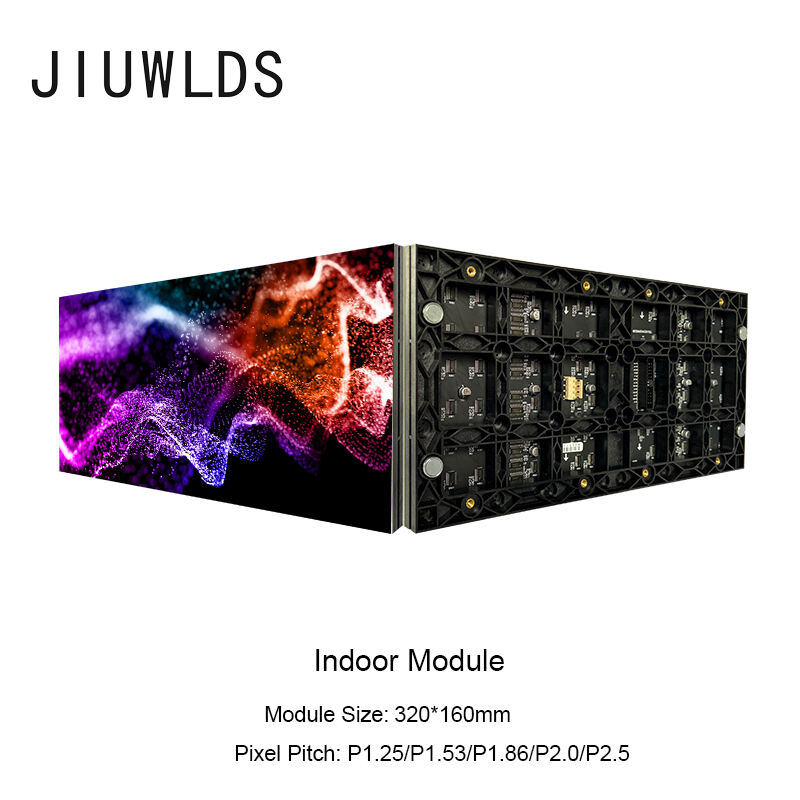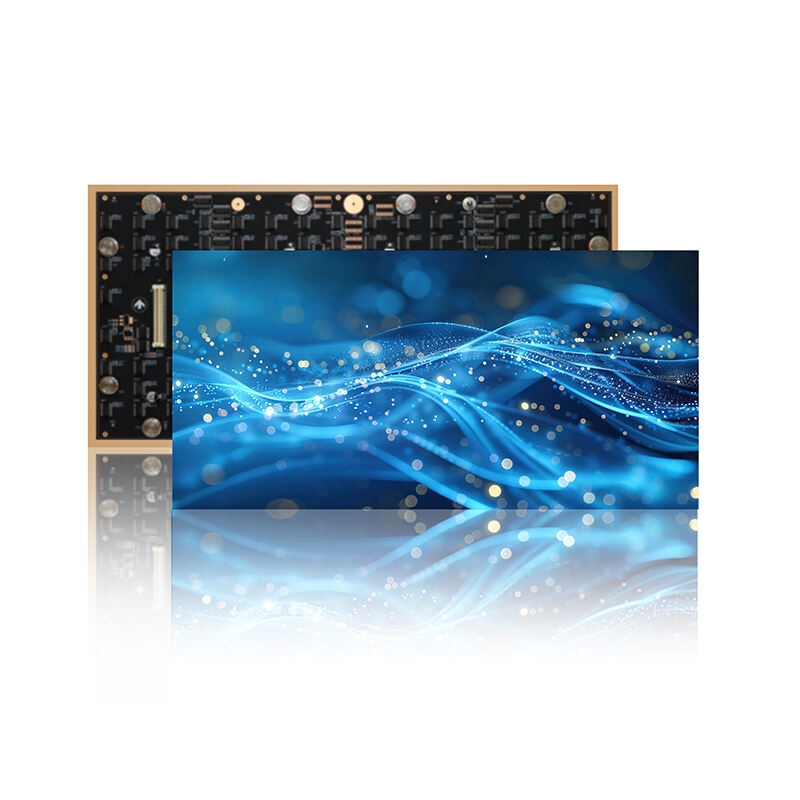Indoor LED Displays: Transforming Spaces with Visual Appeal
Elevating Indoor Ambiance with LED Display Screens
Enhancing Visual Impact Through Brightness and Color Accuracy
LED display screens offer superior brightness levels, often exceeding 1000 nits, which makes them visible even in challenging indoor lighting conditions. This exceptional brightness allows for clear visibility and engagement irrespective of whether the location is a well-lit shopping mall or a dimly lit conference room. Furthermore, the color accuracy of LED displays, achieved through high color gamuts like NTSC 92%, ensures vibrant imagery that captures attention and effectively conveys messages. In contrast, traditional display technologies such as LCDs often struggle to maintain color precision and brightness in dynamic indoor environments. A study published in the Journal of Display Technology indicates that LED displays significantly outperform conventional displays in both brightness and color representation, further enhancing their appeal in settings requiring high-impact visuals.
Dynamic Content Delivery for Immersive Experiences
Content management systems (CMS) have revolutionized how businesses use LED display screens for advertising indoor environments. These systems enable real-time content updates, ensuring messages are always relevant and timely, depending on audience engagement or the time of day. For example, a retail store might use CMS to showcase different promotions during peak hours compared to evening times. By incorporating videos, animations, and live feeds, businesses can create more immersive and compelling visual storytelling that holds audience attention. Case studies have shown that dynamic content can increase foot traffic and engagement in both retail and corporate settings. For instance, a leading European department store reported a 25% increase in customer interaction after implementing a dynamic LED content strategy in its flagship store.
Interactive Features in Modern Indoor LED Displays
Modern indoor LED displays have embraced interactive features like touch capabilities, providing opportunities for customer interaction and personalized experiences. Sensors and mobile connectivity are increasingly being integrated into these displays, enhancing user engagement while gathering valuable consumer data. These features allow the displays to act as interactive kiosks in trade shows, where potential clients can explore product details at their leisure. Successful implementations include retail spaces employing interactive LED screens that allow customers to browse catalogs or provide feedback, transforming the shopping experience. For example, a major tech company showcased its new gadgets in a trade show using LED screens with touch capabilities, significantly boosting visitor interactions and informative engagement.
Conference Rooms: Clarity and Collaboration
High-resolution LED displays are essential for delivering clear and impactful presentations in large conference rooms. These screens, often boasting resolutions of 4K and above, provide the clarity needed to ensure every detail is visible to attendees. The sharpness of the image aids in making information easily digestible, hence improving meeting efficiency. Additionally, LED displays enhance collaboration by allowing content to be shared wirelessly. Participants can seamlessly contribute to discussions by displaying their content on the main screen, fostering a more inclusive and productive meeting environment. According to a study published by Wainhouse Research, meetings utilizing high-quality visual aids resulted in 30% improved comprehension and retention rates among participants. This underscores the significance of deploying LED displays in professional settings where clarity and collaboration are paramount.
Retail Spaces: Indoor Advertising LED Display Screens for Brand Engagement
Indoor advertising LED display screens play a pivotal role in capturing consumer attention and driving sales in retail spaces. Research has shown that such screens lead to increased engagement rates by creating vibrant and dynamic advertising content that stands out. These displays can be strategically placed to optimize visibility and interactivity, ensuring that potential customers are drawn to them. For instance, retail spaces have successfully enhanced customer shopping experiences by showcasing interactive campaigns and live updates that engage visitors. Not only does this enhance brand engagement, but it also boosts the likelihood of converting visits into purchases.
Exhibition Halls: Large-Scale Visual Storytelling
In exhibition halls, large-format LED displays serve as powerful tools for creating captivating visual narratives. These displays offer the ability to integrate various media types, such as video, animations, and graphics, which enrich the storytelling experience. By leveraging these capabilities, brands can craft immersive narratives that enhance their presence and leave a lasting impression on visitors. For example, companies at trade shows often use these expansive screens to highlight their brand through visually engaging content that is memorable and impactful. Such immersive storytelling not only boosts brand recognition but also aids in increasing visitor recall, ensuring the brand remains in attendees' minds long after the event.
Entertainment Venues: Indoor Rental LED Displays for Flexibility
Entertainment venues benefit enormously from the flexibility offered by modular rental LED displays. These screens, known for their adaptability, can be tailored to fit a variety of event layouts ranging from concerts to theater productions. High-resolution LED displays enhance the visual experience, making performances more engaging by delivering crisp and clear images that captivate audiences. Moreover, there is a growing trend toward the use of rental displays in the entertainment sector, as they provide the versatility needed for different types of events. The demand for these displays is spurred by their capability to transform spaces and elevate the audience's experience, offering venues a chance to create unforgettable events.
Slim Bezels and Modular Designs for Seamless Aesthetics
The aesthetic appeal of indoor LED displays is significantly enhanced by slim bezels, which create a nearly borderless look, seamlessly blending with any interior décor. This design feature not only boosts the visual appeal but also integrates smoothly with modern, minimalist styles where clean lines are critical. Additionally, the modular nature of these displays allows for creative configurations tailored to various spaces and themes. A modular system can be adapted to fit specific architectural demands, ensuring flexibility in installation. Consider the example of a luxury hotel lobby where an indoor LED display enhances the streamlined design while providing high-resolution content that captivates guests the moment they enter.
Customizable Shapes: Curved and Flexible LED Solutions
LED technology's ability to be shaped into unique forms, such as arches and waves, allows it to fit unconventional spaces whether they're commercial, educational, or recreational. These customizable shapes permit limitless design possibilities, turning any space into a captivating environment. Curved displays, for example, are frequently used to create immersive venues that draw audiences into a more engaging experience. Businesses like cutting-edge tech stores or avant-garde galleries have utilized these customizable LED displays to create an engaging brand narrative and enhance customer experiences, turning regular visits into memorable visual tours.
Material Finishes to Complement Interior Themes
Various material finishes available for LED displays offer designers the flexibility to match them with different interior styles, such as metallic for a futuristic look or matte for subtle elegance. The choice of material finish can influence light reflection, impacting the display's visibility and ensuring it gels with the surrounding design theme. For instance, a matte finish might be chosen for an area with reflective surfaces, reducing glare to enhance viewer comfort. Case studies from luxury retail stores highlight transformations achieved with well-chosen finishes, illustrating the LED displays' role in harmonizing with and enhancing the existing aesthetic of a space.
Daily Cleaning Protocols for Indoor LED Display Screens
Daily cleaning is vital to maintaining the clarity and longevity of indoor LED display screens. Routine maintenance helps prevent dust build-up, which can compromise visual quality. We recommend using specialized cleaning agents like screen-safe liquids and microfiber cloths to avoid scratching the surface. It's essential to clean the display at least once a day in high-traffic or dusty areas, while weekly cleaning might suffice in less busy environments. Keeping up with these protocols ensures your display remains in top condition. Industry experts, including LED maintenance technicians, emphasize that regular cleaning significantly extends the lifespan of LED displays and keeps images sharp and bright.
Managing Environmental Factors: Humidity and Temperature
Understanding the impact of environmental factors such as humidity and temperature is crucial for the optimal performance of indoor LED displays. LED screens generally perform best in environments with stable conditions, including humidity levels between 30% to 50% and temperatures ranging from 10°C to 35°C. To combat excessive moisture or temperature variations, you might consider incorporating climate control systems or protective casings. Manufacturers often highlight the importance of managing these conditions to prevent any long-term damage to the equipment. Following these guidelines not only prolongs the system's functionality but also maintains vibrant visuals, critical for captivating audiences.
Software Updates and Hardware Diagnostics
Routine software updates and hardware diagnostics play a pivotal role in maintaining the efficiency and security of indoor LED displays. Regularly updating software ensures the display can access new features, improvements, and security patches. Performing hardware diagnostics is equally important, as it helps identify potential malfunctions before causing significant issues. Best practices dictate setting a schedule for both software updates and hardware assessments to avoid unexpected downtimes. By staying proactive, you safeguard the performance and reliability of your displays, ensuring they deliver consistent quality over time.







 Hot News
Hot News